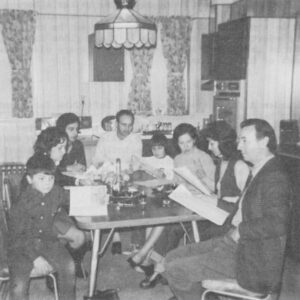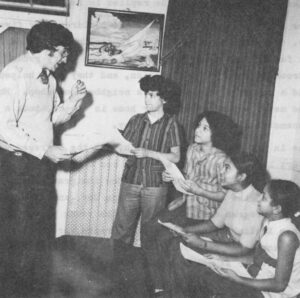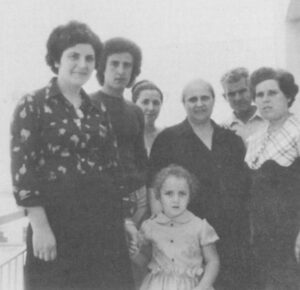The history of American immigration, like most history, has generally been written by and about men. The immigrant woman tends to appear in two guises: the totally ethnocentric mainstay of the family, fighting any outside influences that might weaken her hold on her only domain, and the exploited working girl forced by cruel economic hardship to toil in ways unsuited to “feminine nature.” Popular history and literature provide only sporadic glimpses of the special bravery of women who ventured into a strange land at a time when the vast majority of immigrants were men. They were women who displayed as much courage in dangerous factory jobs as they did in the dangerous childbirth of the poor, and their struggles have not been described adequately. The Italian mill women who carried banners proclaiming “We Want Bread and Roses Too” in the bitter Lawrence (Mass.) textile strike of 1912 have occupied a smaller space in the national consciousness than immigrant girls who were forced into brothels to make a living. In reading the popular press from the turn of the century, I was struck by the amount of space devoted to the sexual exploitation of women by unscrupulous employers. I suspect that the number and sensational nature of these articles revealed more about the interests of male reporters and editors than about the real hardships of immigrant life; the grinding economic oppression of both male and female workers was of immeasurably greater importance than white slave rings and sexual blackmail on the job.
There are, of course, exceptions to the stereotyped portrayal of the immigrant woman. One of the most notable is Mario Puzo’s novel The Fortunate Pilgrim, a magnificent portrait of an unbeatable Italian immigrant woman who keeps her family together and manages to fulfill many of her dreams after her husband’s death. (Although the novel received highly favorable reviews, it was a commercial failure. The book was re-issued after the enormous success of Puzo’s The Godfather, but it has continued to sell poorly. The reading public clearly prefers the Mafia to one of the most memorable female characters in American literature.) Some of the best accounts of the real concerns of immigrant women can be found in primary sources. In letters to the Jewish Daily Forward, Jewish women revealed the complexities of their lives in ways that would escape their sons, the authors, when they wrote about their overbearing mamas a generation later. One letter, dated 1906, came from a woman who immigrated to America as a child. “Later I was married here,” she wrote. “I was never rich financially, but wealthy in love. I loved my husband more than anything in the world. We had seven children, the oldest is now thirteen…after years of hard work, my husband developed consumption…. My husband told me he had opened a small business in Colorado, and hoped to make a living. But I heard him cough, and when I questioned him, he answered with a bitter smile that there was no cure for his illness. I immediately saw my tragedy and wouldn’t let him work. I went out peddling with a basket, and left him at home with my children.” 1
In 1910, another woman reader wrote:
Since I do not want my conscience to bother me, I ask you whether a married woman has the right to go to school two evenings a week. My husband thinks I have no right to do this….
Now he has announced a new decision. Because I send out the laundry to be done, it seems to him that I have too much time for myself, even enough to go to school, So from now on he will count out every penny for anything I have to buy for the house, so I will not be able to send out the laundry any more. And when I have to do the work myself there won’t be any time left for such “foolishness” as going to school. I told him that I’m willing to do my own washing but that I would still be able to find time for study.
When I am alone with my thoughts, I feel I may not be right. Perhaps I should not go to school. I want to say that my husband is an intelligent man and he wanted to marry a woman who was educated. The fact that he is intelligent makes me more annoyed with him. He is in favor of the emancipation of women, yet in real life he acts contrary to his beliefs. 2
The author of the second letter clearly came from a family that had already worked its way out of the impoverished condition of new immigrants. (Most immigrant women did not “send out” the laundry.) Unfortunately, there are few written accounts of the lives of immigrant women from ethnic groups that did not value education as highly as the Jews. Jewish and Italian women both went to work in garment factories, but the Jews tried to send their children to high school or even college while the Italians sent their sons to work on the docks and prepared their daughters for early marriage. Differences in immigrant family patterns — differences in which women played a central role — have an important impact on the status of third- and fourth-generation American women today. “It’s not surprising that Italians are much more likely to want to keep women in the home than Jews are,” says a fourth-generation Italian-American who was the first woman in her family to go to college. “Our people are several generations closer to the time when ‘success’ meant having enough money so the woman didn’t have to work 14 hours a day in a garment factory. The Jews went through that stage a long time ago. The biggest thing in my grandfather’s life was when he made enough money so my grandmother and my mother — his daughter — didn’t have to do sewing. My parents absorbed that attitude, and they don’t know why I would want to work when it isn’t absolutely necessary for the money.”
In examining the lives of women who are arriving in the United States as immigrants today, it would be a serious mistake to minimize differences in ethnic and cultural background — differences which may influence social behavior in this country for several generations. Chinese and Italian women, for example, seldom immigrate without their parents or husbands. Women from the Caribbean and Central America frequently do immigrate by themselves; they contribute to the support of parents, children and sometimes husbands at home. Some of them save money to bring their families to the United States, just as immigrant men did at the turn of the century. (Others return home many times before they decide whether to settle permanently in the United States. This pattern also corresponds to the behavior of southern European immigrant men between 1880 and 1924.) Reasons for the differing immigration patterns of women lie in a combination of economic and cultural factors in their native lands rather than in American society. These range from sexual mores to the kind of job training available in their own countries. For example, many nurses in New York City hospitals received their professional training in Jamaica. As a rule, West Indian men do not take advantage of nurse’s training programs in their own countries because nursing is considered “woman’s work.” However, a woman with a nursing background has a distinct advantage in the New York City job market because there is such an acute shortage of hospital personnel; she may earn much more money than an immigrant factory worker. “The opportunities here are well-known to women in my country who have some education,” says a 30-year-old nurse from Barbados who received some of her training in Jamaica and some in New York. She arrived in the United States six years ago and is now a registered nurse who works mainly with private cases. She makes $5 an hour and receives more calls for work than she can handle. “A young woman with some training can come here alone and unmarried and be confident that she can support herself. When I came here I only qualified as a practical nurse, and I took courses later on to become a registered nurse. I thought things out very carefully before I decided to immigrate; a woman who immigrates alone has to do this. It sounds like one of those soap operas, but a girl who comes here alone is likely to wind up with the wrong kind of man if she doesn’t have a definite way to make a good living. Work is the only reason to come to a strange land if you don’t have relatives here.”
There has been a substantial change in the sex distribution of immigrants since the turn of the century, when many men left their families behind until they decided whether they wanted to settle permanently in the new land. 3 More than 80 per cent of Italians who arrived during the old wave of immigration were men, but nearly half of Italian immigrants since 1965 are women. In 1973, the total number of women immigrants outnumbered men 213,743 to 186,320.
This figure reflects in part the 1965 liberalization of the basic American immigration law, which increased the number of immigrants from Asia and Southern Europe and placed priority on uniting families. In some instances, the new law simply facilitated a normal flow of female immigrants who had been barred by explicit racial and ethnic discrimination in previous immigration laws. (For all practical purposes, Chinese women were barred from entering the country between 1924 and 1965. Immigration by wives of Chinese-born laborers was forbidden long before 1924, and immigration of merchants’ wives and wives of American-born Chinese was prohibited in the highly racist, xenophobic legislation after World War I. Some Chinese women did enter the country under special acts admitting war brides and refugees after World War II, but normal immigration of women was not permitted until 1965.)
The increase in the percentage of women immigrants is due not only to changes in American law but to shifting attitudes about family relationships around the world. In the Italian town of Mola di Bari, I spoke with dozens of elderly woman who remained behind while their young husbands went to work in the United States. Many of the children have immigrated to the United States during the past ten years, but the husbands no longer leave their wives in Italy. “It was normal for us to live in a town where all the men were gone,” recalled a 79-year-old woman whose three children now live in Brooklyn. “We didn’t even think about it. It was our way of living — the men going back and forth across the ocean where there was work, the woman staying behind and taking care of the children. But this way of life is completely unacceptable to my children who are now in their forties, and my grandchildren can’t even imagine it. Neither the men nor the women want to live a life in which husband and wife are separated for years at a time. I was afraid to leave my family and the town where I grew up — young women today aren’t so reluctant to leave their parents. And it’s better this way. The women of my generation were too attached to the past. It’s better to be connected to the future.”
Hard work is the one element that has not changed in the lives of immigrant women during the past hundred years. Immigrant women in the United States usually expect to work outside their homes, regardless of whether they ever held jobs in their native lands. And many immigrants who come from areas of the world in which there were only a handful of jobs for men regard employment opportunities for women as a blessing. “We want to make up for the time when there were no jobs for anyone,” explained Mrs. Anna Constantin, who left her native island of Crete five years ago. Her husband drives a cab, and she works in a garment factory for $3.25 an hour. “When I came here, I expected to work in the sewing factory. This money I make, it’s not a lot to Americans. My money and my husband’s money together will keep our children in school. Sometimes I look around the factory and I think how could I leave my island — it’s so beautiful — for all of this dirt and noise. But the island is so poor. No chance for your children to do any more than you did.” I asked Mrs. Constantin if she wished her husband made enough money so that she did not have to work. “Don’t tell him,” she said, “because that’s what held like. But I like going to the factory. I like getting paid for what I do. I have people to talk to — I’m learning English because one of my friends there started going to night school. If my husband becomes a millionaire — not that this will happen, you understand — but if he does, I do not want to sit at home.”
Most immigrant women — with the exception of those from the Caribbean — have had less education in their native lands than their husbands. If the men have completed the equivalent of high school, their wives usually have an incomplete high school or elementary school education. Southern European or Southeast Asian men who completed six or seven grades of school are frequently married to women who completed three or four grades. In some of the immigrant families I have interviewed, the men are literate in their native languages while the women are not.
Because of their limited education and skills, many immigrant women must find jobs that do not require any knowledge of English; such jobs are usually found in neighborhood garment factories or other small businesses. Men are more likely to look for work that requires them to deal with the world outside their immigrant communities. When a woman lives and works in a large urban neighborhood with many immigrants from the same country, she does not need English to conduct her everyday affairs. One 50-year-old woman in Bushwick, a section of Brooklyn with many new Sicilian immigrants, has lived in this country nine years without learning any English (although her children have all learned English and found jobs outside the neighborhood). She worked at the same garment factory until it was closed by the owner six months ago. The factory manager, a family friend, offered her a job in another shop only two subway stops away. The woman turned down the job because she did not know enough English to read signs and was afraid she would get lost and have to ask for directions.
In my experience, Mrs. Constantin’s story is more typical of the efforts of immigrant women to work, maintain a warm family life and make their own adjustments to the new culture. “I only went two years of school in Crete,” Mrs. Constantin said, “and I am very ashamed of this in front of my children. Even in Greece, where so many have no schooling, I am still ashamed. Here I am even more ashamed when they start to learn English. How, I ask, can I go to school and talk to their teacher? But when I go to the factory, I see other women who learn English at the night school. I go with my friend, and I learn not just to speak but to read and write a little. What I don’t do in my own language, I do here. My husband, he is ahead of me because he talks to Americans in his cab. But I go to school now, and I can talk to the teachers of my children. I am proud.”
Because more immigrant children attend high school and college today than 100 years ago, their mothers have more immediate contact with American society. These women contradict the old stereotype of the provincial, ethnocentric mama: many of them are more realistic than their husbands about the cultural conflicts of being an immigrant. One Italian woman whose daughter is the first girl in the family to attend college says she is already preparing for the day when her daughter will bring home an “American boy.” She says she does not dare mention the subject to her husband. “He (my husband) is very proud that Maria goes to college because he wants all of his children to have education. But he thinks she may still marry a boy from the same town. I myself know this is a dream, even though I was brought up in the old way. I tell my daughter she must bring an American boy home if she likes him, she must explain to him that our ways are different. As the mother, as the wife, I must help my children to live well here without thinking they have to leave their family behind. I must help my husband to understand this. A mother doesn’t just cook the spaghetti sauce, like those commercials on the TV.”
Received in New York on January 6, 1974.
©1974 Susan Jacoby
Susan Jacoby, a freelance writer, is an Alicia Patterson fellow supported by the Rockefeller Foundation. This article may be published with credit to Ms. Jacoby, the Alicia Patterson Foundation and the Rockefeller Foundation.






